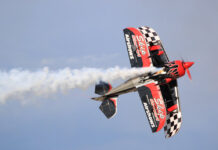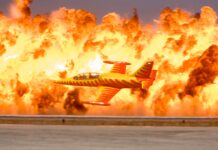On this night, in this town, in this hotel, sleep eludes me. For I have vowed to myself that, on the morrow, I am going to confront a personal demon.
I am going to do a ROTO.
And I am discovering that a man who has thus committed himself becomes strangely thoughtful in the limbo period between vow and execution. In fact, nobody else knows of the vow, so I still have time to quietly forget it and no person will ever be one whit the wiser.
Except me, of course. I will know.
Oh, I have practiced as much as ever one can. Slowed to near stalling speed at low level, hit full power, counted…One…Two… and hit it. Near as you can get….
But not the same as doing it for real.
And in the morning – which for some reason is now approaching with unseemly haste – I am going to do it for real. I have been through it over and over in my mind.
So why do my hands shiver like this?
For real
Morning has arrived. Now, my gloved hands are not shivering except to the normal slight vibration of an idling Pitts Special.
ATC clears me for takeoff. I take a very deep breath. Run up to full power. Lift the tail as we accelerate. Hold it on the runway unnaturally long until a glance shows 100 mph. Snatch it off the ground – and instantly roll upside-down. Sounds simple.
Actually, for some obscure reason, it is kind of alarming when you do it for the first time.
Don’t think; just hit it. It’ll work. You know you can do it; just hit it.
Runway streaming past over the top wing. I can see rubber marks on the tarmac. Oh Jesus, this is low. And there is no horizon because the bloody top wing’s in the bloody way.
And then the ground sinking away above as I climb out inverted. The straps squeeze their tourniquet-tight pressure on my thighs and shoulders like a cuddle to celebrate survival.
I’ve done it! I’ve done the ROTO! The Roll On Take Off.
Begone, night devils; I’ve done it!
Pride cometh before…
Now, please do not think I am actually commending a ROTO as part of any pilot’s curriculum. British Airways definitely regard it as undesirable, and even the most liberal of flying schools purse their lips.
But if you make your living in the display world – why, then, it can be a bit of an earner. One of those earners where you gamble that both your skill and the engine hold up during the crucial bit. There are a handful of such maneuvers – low speed and near the ground – which are like this. You may pay lip service by having a “Master Plan” for if the engine coughs, but in your heart of hearts you know it probably ain’t gonna work. Which means that if anything important ceases functioning in those critical few seconds, there is going to be a nasty scraping noise.
These few maneuvers confound aerobatic competency evaluators. On the one hand you, the evaluator, exist firstly to protect the crowd from any foolhardiness or lack of skill on the part of an air show pilot, and, secondly, to protect the pilot himself from exactly the same thing. Thus, in theory at least, you the evaluator spot any flaws in the execution of maneuvers, mismanagement of energy…101 things.
But where you hit a conundrum is when a competent pilot elects, with calculated aforethought, to execute perhaps one maneuver which he knows full-well will probably kill him if anything goes wrong. Kill him, but at the same time present no possible danger to the crowd because by no conceivable scenario could any of the wreckage reach them. Do you rule that out?
To my mind, if there is no fault in the execution, you do not. That pilot is a consenting adult. There is no danger to anyone else, and frankly I’d sooner stop people flying singles across the English Channel without wearing a life-jacket; they’re relying on the engine for a lot longer, and it costs a fortune to search for them.
In any event, on this morning three decades ago, any such personage as an aerobatic competency evaluator or display examiner simply does not exist, the entire concept of formal aerobatic competency ratings being far in the future. I am paid for being an air show pilot. If I want to ROTO, it is a matter for me and me alone.
The era might be primeval, but some things do not change – one of them being that if a pilot intends to use a maneuver during the air show, it behoves him to practice it. Thus, in the following weeks I do practice ROTOs quite assiduously. I even fly short sessions of circuits for the express purpose of rolling on each takeoff. This tends to bring people out of the clubhouse, but they get used to it. As do I. I know I am getting better….
Ho! Am I?
I nurse this illusion until one evening in the airfield bar, when the local club CFI oh-so-casually sits down beside me.
“Your rolls on takeoff are getting spectacular, Brian,” he says quietly.
“Well, thanks Pete. I’ve been working on it.”
“Yeah, you have. How much did your wingtip miss the ground by on your last one?”
“I was aiming for about 10 feet. Was it much higher than that?”
“Brian…. look…. it was about two feet”.
I feel the blood draining out of my face. Around me are maybe 40 flyers laughing and chattering – most of whom were probably watching me this afternoon. And who – all but one – must have assumed I meant to do that.
Two feet…..
All of a sudden my stomach has become mysteriously liquid.
The stroke of genius
Over the subsequent years, I saw the same syndrome many times. Pilots watching other pilots and wincing. But who was going to take it upon themselves to have a quiet word? A quiet word with the likes of Neil Williams, Bullock, White, Proudfoot, Bilal, Clark, LeRoy – oh, many more.
You? Criticize the Gods?
But if someone had said something at the right moment, then maybe those Gods would still be around instead of sitting on a cloud trying to figure out how a harp works.
Among the living, you can take the likes of Lecomber, Lamb, Meeson, Bonhomme, Offer, Curtis, Jones, and ask them if a quiet word has ever saved their lives. The fact is I haven’t even bothered to ask them – except myself – because I know it will have done. I have been on both the giving and receiving end.
But…
Where do you get that word? In Unlimited aerobatics, it is commonplace for one pilot at a competition to say to another, “Watch me and give me a critique,” but this is because Unlimited pilots have almost always come up through the competition route, where critiquing each other is as normal as breathing.
Beyond that, who does watch closely? In the main, to the air show pilot busy with his own cares and woes, the rest of the show sort of goes on in the background; you glance at it often, but it does not have your full attention.
It is supposed to have the full attention of the Flying Control Committee (roughly equivalent to an Air Boss in the US), but this is not infallible. Firstly the FCC will be extremely lucky if it has expertise in everything from Eurofighter to Extra, and, secondly, even it blinks sometimes, looks the wrong way sometimes, and anyway has to go for a pee occasionally. The FCC system does work, but it is not infallible.
So where does the quiet word come from?
Enter one Bud Granley, of the USA. One very experienced air show pilot. Not – he would laugh at the suggestion – a genius in the Einstein sense. But a man who has come up with a stroke of genius, this being defined as an idea so bloody simple, so bloody obvious, that the rest of us smite our brows and cry: “Why the f*** didn’t I think of that?”
What Bud says is that every air show pilot, at every show, should pick another pilot in the same discipline and say; “Let’s be buddies today. I’ll watch your sequence with great attention, and you watch mine. Then we’ll swap notes and see if either of us is about to do somethin’ stoopid”.
And that’s it. It is as simple as that. It’s called the Buddy System. No pilot can watch the whole show thoroughly, but if you have a Buddy you make a point of watching his slot, and he yours. Not formal, not official, most certainly nothing written down…just an informal de-brief between the two of you, with safety as the priority.
Bud has introduced the Buddy System at shows he runs as ‘Air Boss’ as a sort of gentle suggestion at the main briefing. No compulsion. Okay, maybe along the lines of, “It’s just a suggestion, but let’s remember where the suggestion is coming from,” but nonetheless just a suggestion.
I gather it has caught on well in the US. I hope it will catch on here, and not just in air show flying.
The Buddy System. A stroke of simple, profoundly obvious, beneficial genius.








